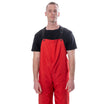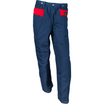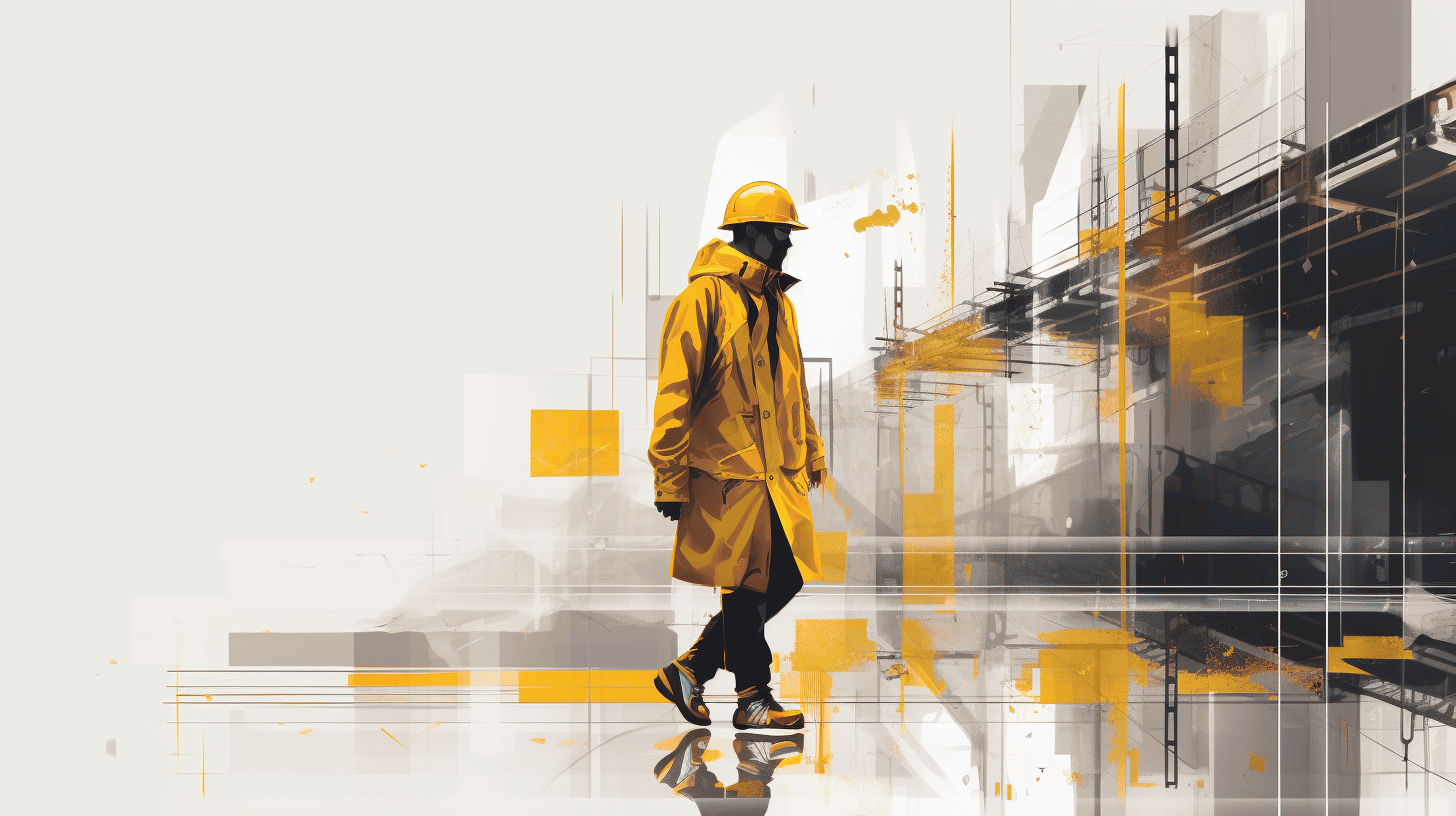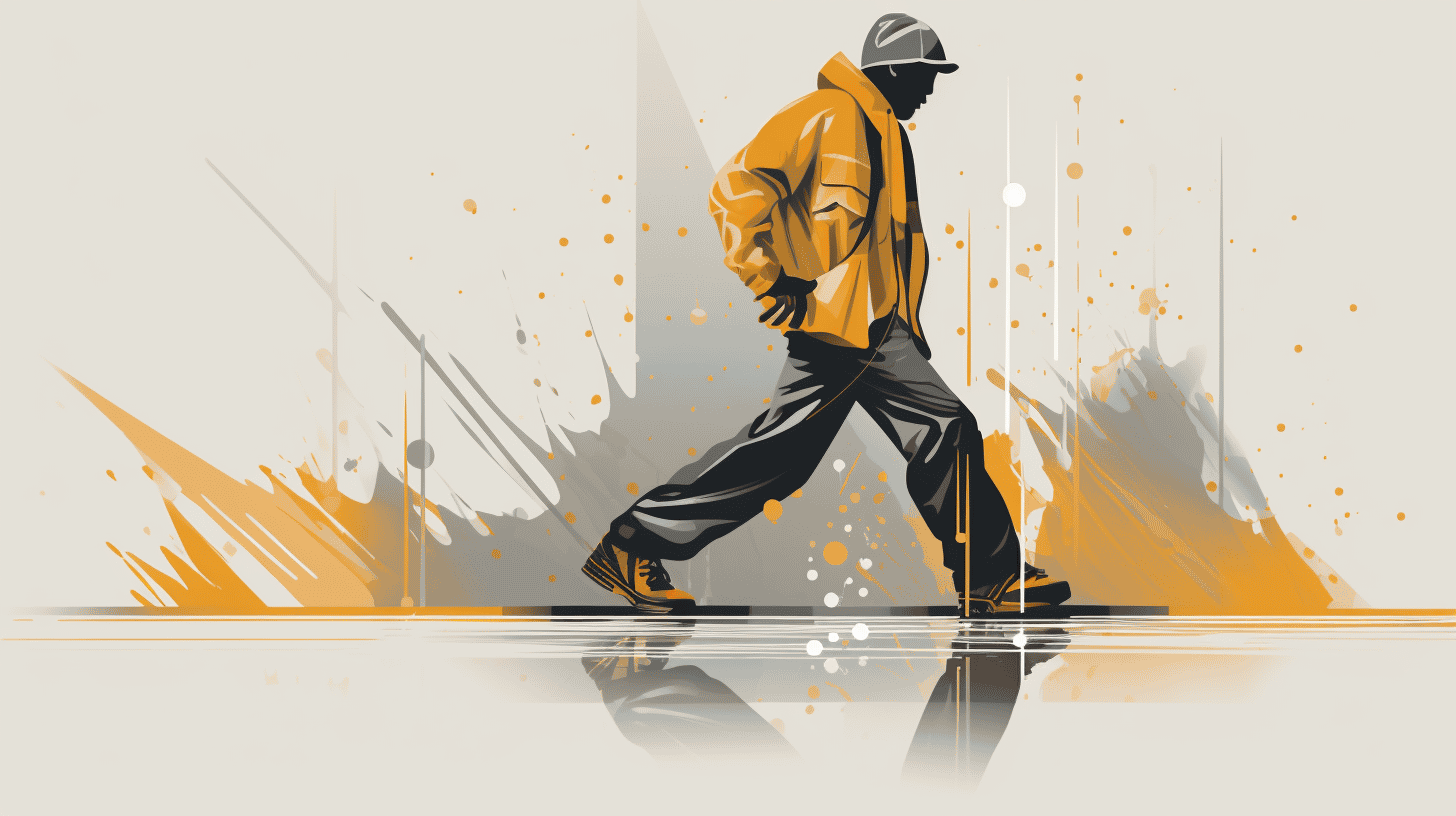Unraveling the Myths about Construction Rain Gear
It is a common sight in a downpour to see construction workers braving the harsh weather shielded by their protective rain gear. Nonetheless, beyond providing protection from the rain, this equipment helps workers maintain productivity in challenging weather conditions. Understandably, the efficiency of this protective wear is often a matter of intense discussion and speculation. The goal of this article is to dispel common misconceptions and provide a comprehensive understanding of construction rain gear. So, read on as we delve into its role in mitigating construction site hazards, its intricate construction, effectiveness, and its applications beyond the construction sector. Along the way, we'll examine high visibility rain gear, popular options available in the market, and the critical role of GORE-TEX in vigilant waterproofing. You'll also get insights into maintaining and ensuring the durability of rain gear, as well as the latest trends shaping the rain gear market.
Construction Site Hazards and the Role of Rain Gear
Life on a construction site often teeters along the thin line between safety and danger. Various hazards exist that pose substantial threats to workers, one of them being inclement weather. In fact, the U.S. Bureau of Labor Statistics (BLS) notes a staggering number - more than 5,000 U.S. workers succumb to fatal injuries on construction sites every year. Amidst these daunting statistics, one unsung hero silently sharpens its protective blade - rain gear.
As it battles against the elements of nature, rain gear performs an essential role in not just deflecting pouring rain, but also holding the line against other hazardous elements. Did you know that quality rain gear helps shield construction workers from the damaging exposure of electric arcs and flash fires? Yes, that's right!
Let's delve into a lesser-known but hugely significant aspect: the role of rain gear in the daily life of a construction worker, a subject that rarely takes center stage amidst the thundering clatter of construction activities.
Having the right protection goes beyond wearing hard hats or steel-toed boots. It includes donning rain gear that ensures you're resistant to many dangers that could otherwise be life-threatening on a rainy working day. Rain gear, often characterized by waterproof, electricity-resistant materials, is pivotal in preventing electric shocks, potential electrocutions, or even flash fires.
However, rain gear isn't just a body shield against physical harm. It boosts productivity, too. Rain or shine, construction work must continue. Adequate rain gear accessories provide comfort and mobility, aiding workers to carry on with essential tasks without disruptions.
Whilst it's easy to get fixated on the power tools and life-saving helmets, the humble rain gear, and its less-obvious, yet massive impact on construction site safety deserves an honorable mention. Its impact on a construction site and the lives of countless workers is tangible, significant, and very much indispensable!
Construction and Effectiveness of Rain Gear
The science behind constructing efficient rain gear is tantalizingly fascinating. Not all rain jackets, shoes, or pants are created equal. Numerous factors play a pivotal role in determining their waterproofness, breathability, and durability. This comprehensive guide will enlighten you on the layers of construction, seam tactics and jacket types, and various materials used in making your trusty rain gear.
Layers and Waterproofness
Delving into the world of rain gear construction, you will often come across terms such as 2-layer, 2.5-layer, and 3-layer. These highlight the design intricacies that optimize a garment's waterproofness and breathability.
- The 2-layer gear includes a protective outer layer fused with a waterproof coat, being the most basic, yet robust design.
- The 2.5-layer construction consists of an extra half layer, a protective print or spray-on 'half layer' added to ward off body oils and dirt that may hamper the waterproof layer.
- Finally, the 3-layer construction is considered superior, boasting an extra fabric layer bonded to the inner side offering rugged resistance against wear and tear.
Understanding these construction layers is key to choosing the perfect rain gear fit for your needs.
Seam Construction and Jacket Type
Beyond layer types, the construct of the seams and the jacket type profoundly influence the durability and overall effectiveness of the rain gear. High-quality gear often features fully 'taped seams' or 'welded seams,' ensuring no pesky water droplets sneak through the stitching.
The jacket type, whether a hard shell, soft shell, or insulated, determines the jacket’s versatility and suitability for various climate conditions and activities. Pairing the right jacket type with the optimal layer construction allows you to crack the best rain gear construction for any situation.
Materials Used in Rain Jackets
Rain jackets utilize a range of diverse materials, each contributing its unique properties to the waterproofness quotient.
- Polyurethane (PU) - This versatile material is recognized for its flexibility and exceptional waterproofness. PU coated jackets work wonders in blocking out the rain, albeit with a compromise in breathability.
- Expanded Polytetrafluoroethylene (ePTFE) - A popular choice in advanced rain jackets, ePTFE offers high durability and excellent water resistance whilst maintaining impressive breathability.
By comprehending the unique attributes of various materials, you can pivot towards the ideal rain jacket that keeps you dry without compromising comfort.
In essence, the craft of rain gear construction is a delicate dance between materials, layers, and seams. Understanding the play between these factors can help you stay dry during the inevitable encounter with a watery onslaught.
Rain Gear Usage Beyond Construction
The surprising versatility of rain gear is often underestimated, especially since it has a perceived image as being solely for construction workers. However, the benefits of robust rain gear extend well beyond construction sites. From agriculture to airports, commercial fishing to emergency response - the need for keeping dry and comfortable does not discriminate.
Agriculture
Think about those who sow our food and harvest it. The agricultural sector, as outdoor work, is heavily constrained by weather. For agriculture professionals, rain gear serves as their safeguard against nature's whims.
- Comfort: Long hours in the fields command comfort, which is precisely what quality rain gear provides. Not only does it protect the wearer from rain, but it also ensures an optimal working temperature.
- Durability: The strenuous nature of farming demands durable attire. A sturdy rain jacket and pants can withstand the rigors of a day on the farm.
- Sanitation: Rain gear also helps keep farmers clean, reducing contamination risks when handling food.
Airports
In an airport, operations keep running, regardless of the weather. Airport ground crew, often working outdoors, undoubtedly benefit from having durable and reliable rain gear.
- Visibility: A feature often associated with rain gear is high visibility, absolutely essential in high-traffic areas like airports for safety reasons.
- Weather Resistance: Rain gear shields the ground crew from downpour, keeping them dry and comfortable.
- Toughness: Quality rain gear holds up against harsh field conditions, including being scraped or jostled amidst the bustling airport tarmac.
Commercial Fishing
On rough seas with an even rougher weather, commercial fishing becomes a daunting task. Rain gear is an indispensable tool for those who reel in our seafood.
- Waterproofing: The nature of fishing makes waterproof attire not just an accessory but a necessity.
- Temperature Control: Fishing waters can be frigid. Insulated rain gear enables fishers to brave those chilly winds without discomfort.
- Safety: Safety on slippery decks is of prime importance, and the right rain gear can mitigate accidents.
Emergency Response
Lastly, consider emergency services that are vital to saving lives. Whether it's a fireman, paramedic, or search and rescue team, having reliable rain gear is needless to say, a lifesaving amenity.
- Protection: Wet conditions can drastically affect the functionality of these heroes. The protective layers of rain gear enable them to venture into harsh conditions.
- Versatility: Emergency situations can spring up in various environments, making versatile rain gear the preferred outfit.
- Visibility: High visibility variants of rain gear ensure these individuals are noticeable even under poor light conditions, enhancing safety.
Rain gear's ubiquitous usage in various industries underlines its practicality and unparalleled functionality. While it may be synonymous with construction, its value extends to any profession that requires braving the elements. Robust, reliable, and waterproof, rain gear proves to be an indispensable ally in multiple sectors.
High Visibility Rain Gear
All too often, working environments present differing degrees of hazards, often magnified by inclement weather. Among the numerous challenge rain brings, reduced visibility is particularly significant, often increasing the chances of accidents. In the heart of such scenarios, having high visibility rain gear is not an option but a necessity. They provide that critical cushion of visibility and safety in hazardous conditions, primarily in wet and rainy conditions, and most notably in environments where bright, reflective clothing can be the thin line between danger and safety.
High visibility rain gear, often termed hi-vis, is specially designed with reflective properties that bounce off light, ensuring the wearer remains conspicuous in conditions that ordinarily could reduce visibility. As the name implies, these pieces of equipment are primarily for use during rainy conditions, seeing as rain and water in general present a significant challenge to visibility.
Now, getting hi-vis gear isn't as simple as ordering for a jacket or trouser with reflective properties. No, there's a science to it. What materials are perfect for the best reflective effect? How much of the gear needs to be covered in reflective material?
First off, let's delve into the right materials for your rain gear. Hi-vis gear for rainy conditions is typically made of waterproof materials to keep you dry during rainfall. However, it's not just about being waterproof. The material must have excellent light-reflecting properties. This attribute is mainly achieved by coating the gear's material with small glass beads that bounce off incident light, making the wearer easily noticeable.
The coverage of the reflective material on your rain gear is as important as the material itself. For maximized visibility, you'll want hi-vis rain gear that has an extensive coverage of the reflective material—ideally all around the body. This design ensures that no matter the angle, the wearer can be seen.
Identifying the perfect high visibility rain gear may feel like attempting to crack a complex code. But armed with the right information, this doesn't have to be the case. Navigate the confusing maze of hi-vis rain gear selection by understanding the key features of high visibility rain gear and the specific characteristics that set apart the best rain gear intended for construction work.
Identifying the perfect High Visibility Rain Gear, ideally suited for your need, is as much an art as it is a science. It requires a balance between understanding material science and gauging personal comfort levels. But once you're armed with the right knowledge, it's a challenge you're well-equipped to ace.
Remember, don't compromise on your safety. Especially not because of a little rain. Invest in high-visibility rain gear and put your safety and those around you first.
Available Options for Construction Rain Gear
Coping with inclement weather is a familiar challenge faced by construction workers. Torrential rains can quickly turn a day’s work into a soppy, miserable experience. Therefore, having the right rain gear for construction tasks is critical for performance, comfort, and safety. In this article, we'll delve into the go-to options of rain gear for construction workers - from jackets to pants and full rain suits; all tailored to keep you dry and comfortable.
Jackets
Rain jackets are a sought-after choice for many workers. They provide an ideal blend of mobility and protection against the rain. Treated with waterproof coatings and incorporating hoods for covering your head, the rain jackets offer full upper body protection. However, they’re not all created equal; while some simply shield against rain, others are lined with insulation for warmth, reflective materials for visibility, or pockets for storage. Thus, it becomes important to choose a rain jacket that not only ensures dryness but also addresses your needs on the job site.
Pants
Diving in further, rain pants are another pivotal element in your rain gear checklist. While they might initially seem less necessary than a jacket, getting soaked from the waist down can take a real toll on your overall comfort and work productivity. Similar to rain jackets, you’ll find a wide range of rain pants that vary in their level of water-resistance, durability, breathability, and additional features like knee pads and extra pockets. Pair rain pants with your jacket to ensure complete protection against the elements.
Full Rain Suits
Lastly, for comprehensive protection from the rain, a full-body rain suit becomes a necessity. These full suits cover your torso, arms, and legs, offering an all-in-one solution to staying dry in the rain. Their edge lies in the connective coverage they provide, leaving less room for moisture to seep into the gaps between your jacket and pants. These, too, come with a variety of feature sets to cater to different needs and preferences.
By late, as technology evolves, so does rain gear. The year 2023 looks promising, teasing innovative rain gear options for construction workers, leading with waterproof Bluetooth-enabled jackets and breathable rain pants. Looking ahead, adapting to these advancements will keep construction workers a step ahead in tackling unfriendly weather conditions.
For a more comprehensive guide on choosing the best rain gear this year, have a read of our 2023 Rain Gear Options guide. Armed with the right knowledge and gear, you can turn any rainy day on the site into a productive one, rain or shine!
Stay tuned for more insights on construction rain gear, always designed with your comfort and protection in mind.
Maintenance and Durability of Rain Gear
The longevity of your rain gear rests on two remarkable pillars - maintenance and durability. These aspects of rainwear intertwine, working jointly like a trusty, efficient team battling the odds. But, why should you consider them? Here's why: Rain gear, just like any other clothing, needs a consistent regimen of upkeep and care. Why? Well, it's simple because the water-repellent finish that gives the gear its 'rain-fighting' superpower may diminish over time and with consistent use.
Rain gear maintenance positions you ahead of challenges. Think of it this way - if you maintain your gear regularly, your wet weather ally stays in top shape for much longer. Consequently, you don't only save costs on frequent replacements, but you also enjoy the comfort of having reliable rain gear.
So how do you maintain your rain gear to ensure top-tier durability? Here are a few handy tips:
- Cleaning: Regular cleaning is undeniably essential. However, avoid harsh soaps and detergents. They can harm your gear's water-resistant finish. Secondly, the type of water used has a significant impact. Lesser-known fact: hard water can be detrimental to your gear, minimize its use if possible.
- Storage: The way you store your rain gear when it's not in use contributes significantly to its lifespan. Keep it dry, well-aired, and away from direct heat sources.
- Restoring water repellency: Notice your gear is soaking up a bit of water? It might be time to restore the water-repellent finish.
- Timely repairs: Small holes and tears will happen. Major problem? Not if they are repaired promptly and correctly.
With both maintenance and durability in check, your rain gear can brave many a storm and keep you comfortably dry. And in this comfort lies the marvel of proper upkeep and reliable gear, where Rain Gear Maintenance & Durability really shine through. After all, who wouldn't want gear that marries comfort with durability? The takeaway? Respect your rain gear, It'll return the favor tenfold! Remember - good gear is not necessarily the most expensive one but the one that is cared for and maintained regularly. So, get started on it today!
Growth and Trends in Rain Gear Market
Now, more than ever, we see the surge in demand for high-quality rain gear, and this trajectory isn't expected to slow down anytime soon. Whether it's because of a hike in outdoor activities, an increasing number of construction sites or a surge in climate change-induced weather variations, the market for rain gear has never been so vibrant and forward-moving. Interestingly, one sub-segment of this market displaying significant growth is high-visibility rain suits.
High-visibility rain suits are not just your regular rain protection outfits; they are specially created with highly reflective materials for industries such as construction, emergency services, and even cycling, where visibility can be a critical safety factor. The growth of this subset indicates an increase in our collective awareness and appreciation for safety and protective measures.
From our current standpoint, here are key reasons why high visibility rain suits market is projected to grow significantly in the next few years:
- Improving Worker Safety Standards: As companies around the world are becoming more safety conscious, industries such as construction are expected to elevate their protective gear standards. Top construction companies now actively encourage employees to use high visibility rain gear, boosting the sales in this segment.
- Extreme Weather Conditions: With climate change intensifying, severe weather conditions like heavy rain and storms are becoming increasingly common. This drives up the demand for durable and highly visible rain gear for outdoor workers and enthusiasts alike.
- Higher Purchasing Power: Improved economic conditions and rising incomes have led to consumers' willingness to spend more on high-quality gear that offers better protection and utility.
Apart from these factors, another clear driver of this growth trend is the relentless pursuit of industry leaders in constant innovation. Our Rain Gear Market Growth write-up provides an in-depth look at how these industry front-runners continually push the boundaries to provide consumers with unbeatable rain protection.
The growth in the rain gear market, particularly the high visibility rain suits, is a reflection of the larger societal and economic changes we're experiencing. As we continue to see these changes unfold, we can rightly expect the rain gear market to keep marching forward, braving all storms, much like the people it so faithfully adorns.
The Role of GORE-TEX in Rain Gear
When it comes to enduring the elements, the right piece of gear can make all the difference. Whether it's a cozy sweater for chilly winter days or a trusty rain jacket for those surprise showers, the fabric used in your gear can be the difference between discomfort and total satisfaction. Enter GORE-TEX – a game-changer in rain gear.
GORE-TEX fabric has transformed our relationship with rain gear in a big way. But what makes it so unique? GORE-TEX fabric revolutionizes the concept of 'breathable' waterproof materials. It's all down to microscopic holes, smaller than water droplets, that prevents rain from entering your garment. But here's the clever bit - while these minuscule holes are small enough to block water, they're large enough to allow water vapor (like sweat) to escape. This strikes that perfect balance between keeping you dry from the rain outside, but not drowning in a pool of your own perspiration - a common concern with other waterproof materials.
Let's take a look at how GORE-TEX plays its role in rain gear:
- Water resistance: Thanks to the unique technology, GORE-TEX materials can effectively keep water at bay. No longer will you need to worry about walking in a downpour; your GORE-TEX jacket will keep you dry.
- Breathability: Even in wet conditions, the breathability of GORE-TEX materials ensures you won't feel stuffy or uncomfortable. Plus, this breathability aids in the prevention of excessive sweating, ensuring you stay fresh no matter the weather.
- Durability: GORE-TEX materials are renowned for their durability. Jackets and other rain gear made from this material can withstand harsh conditions while maintaining their waterproof and breathable properties.
The Role of GORE-TEX is not only instrumental in making sure you stay dry during that spontaneous summer storm, but it also makes sure you remain comfortable throughout. It's a revolutionary approach to dealing with rain and moisture, one that's not only practical but more enjoyable too.
In a nutshell, GORE-TEX has redefined what it means to have proper rain gear. It excellently balances waterproofing with breathability, ensuring comfort in a wide range of weather. So, before your next excursion into the great outdoors, bear in mind the crucial role of GORE-TEX in your rain gear selection.
Conclusion
As we come to the end of this overview, it's evident that when it comes to providing safety, comfort, and ease of movement, rain gear plays a fundamental role, not just in the construction industry but in various industries including agriculture, aviation, commercial fishing, and emergency response. The design, effectiveness, and versatility of rain gear have seen significant improvements over the years, thanks to advances in technology and materials. From the basic rain jacket and pants to full rain suits, there is a wide array of options available, each designed to suit specific needs and conditions.
More so, rain gear's durability is underscored by the proper maintenance, ensuring it remains effective over a longer period. The trends in the rain gear market point to a sustained interest and growth, further highlighting the fundamental role it plays in a myriad of industries.
However, it's crucial to remember that all rain gear is not created equal. Top-quality gear like that produced by Rain Gear Pro, a company renowned for its 100% waterproof and rip-resistant products, provides the assurance of safety and satisfaction.
Rain Gear Pro handcrafts its products in the Pacific North West, using 100% North-American-Made materials. This assures not only sturdy and durable gear but also gear that offers breathability for ultimate comfort. The high-visibility striping on the gear further enhances safety- ensuring that regardless of where your tasks take you, or whatever Mother nature throws at you, you stay dry, comfortable, and most importantly, safe.
Investing in quality rain gear isn't just about weathering the storm; it's about ensuring you're adequately equipped for the journey ahead. Choose wisely, choose Rain Gear Pro.
Frequently Asked Questions
-
Is construction rain gear necessary?
Yes, construction rain gear is necessary to protect construction workers from getting wet and cold during rainy weather. It also helps to maintain comfort and productivity in adverse weather conditions.
-
What are the important features to look for in construction rain gear?
Important features to look for in construction rain gear include waterproof and breathable materials, sealed seams, adjustable closures, reflective elements for visibility, and pockets or compartments for storage.
-
Can construction rain gear be worn in warmer climates?
Yes, construction rain gear is designed to be versatile and can be worn in warmer climates. Look for rain gear with breathable materials and ventilation options to ensure comfort and prevent overheating.
-
How do I choose the right size of construction rain gear?
To choose the right size of construction rain gear, refer to the manufacturer's size chart and take accurate measurements of your chest, waist, and inseam. It is important to select a size that allows for ease of movement and layering underneath.
-
What is the recommended maintenance for construction rain gear?
The recommended maintenance for construction rain gear typically includes machine wash or hand wash in cold water with mild detergent. Always follow the manufacturer's instructions for cleaning and drying to maintain the performance and longevity of the gear.





















Leave a comment
This site is protected by hCaptcha and the hCaptcha Privacy Policy and Terms of Service apply.